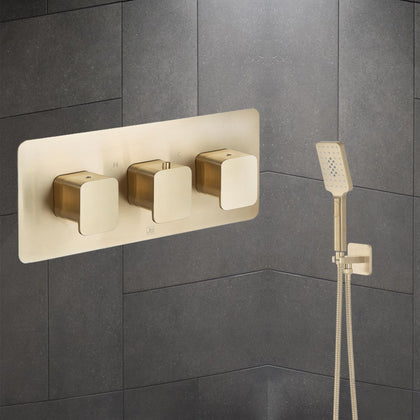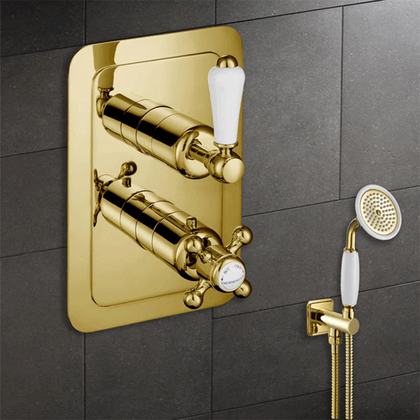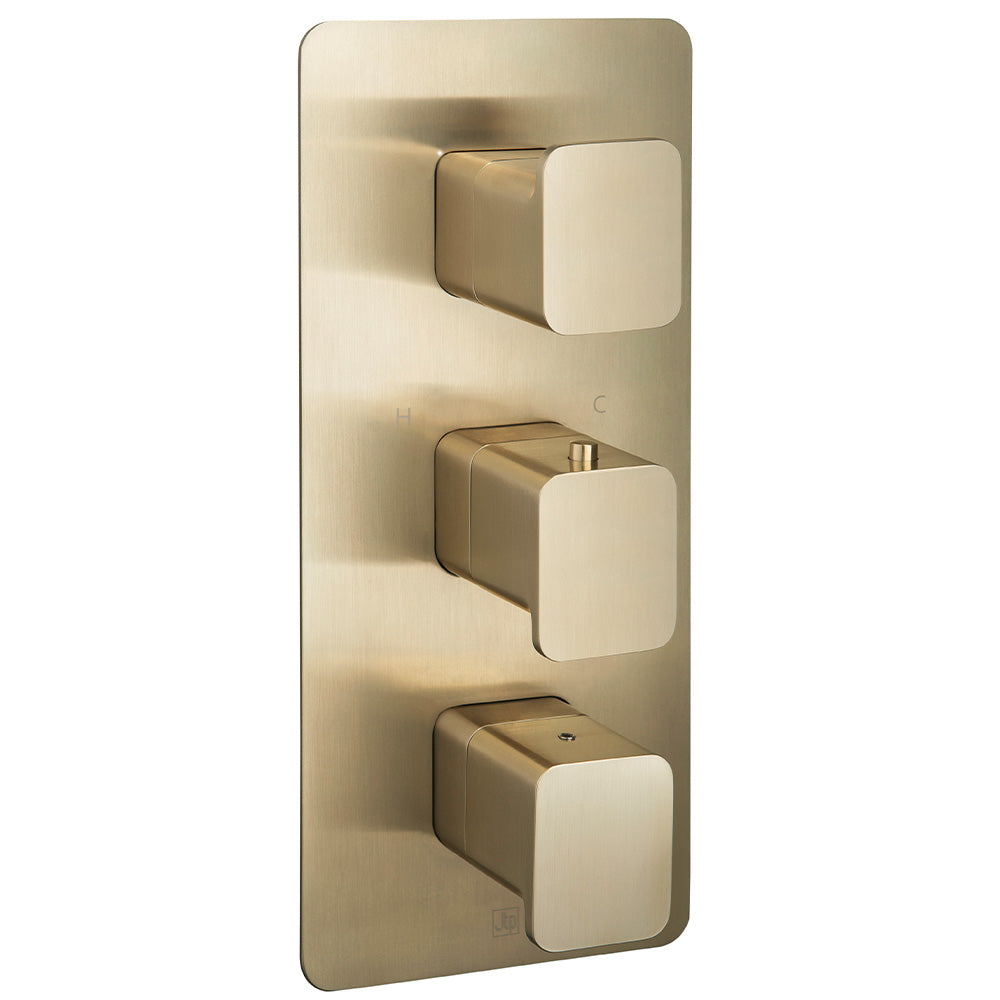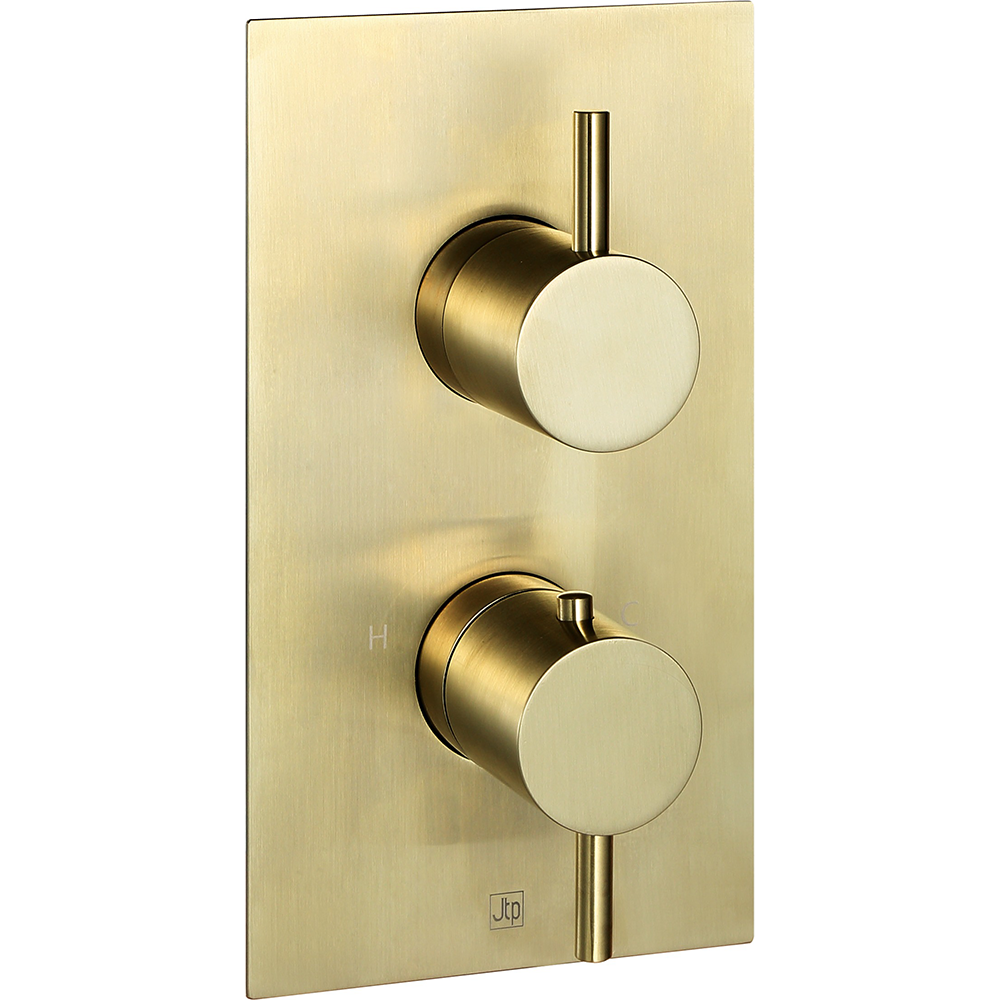What does a shower valve do?
Shower valves function similarly to basin taps, regulating the flow of water for your shower. They come in various styles to complement your shower fixtures and decor. Before exploring options, it's crucial to understand the two primary types of shower valves available.
Shower valves that are thermostatic
Thermostatic shower valves are designed to maintain a consistent water temperature, preventing sudden fluctuations caused by flushing toilets or running taps elsewhere in the house. This feature ensures a safe and comfortable shower experience, eliminating the risk of scalding or freezing blasts of water. Typically, thermostatic shower valves feature two or more handles. One handle is dedicated to adjusting the temperature, allowing users to find their preferred level of warmth. The other handle controls the water flow, allowing for easy on/off operation. Once the temperature is set, users can simply leave the thermostat untouched, ensuring that the water remains at the desired temperature every time they turn on the tap. For showers with multiple outlets, such as body jets or conventional showerheads, thermostatic valves with three handles, known as triple thermostatic valves, are available. These valves allow users to control two outlets simultaneously, ensuring a customized shower experience tailored to their preferences. Families with children often opt for thermostatic shower valves due to their anti-scald feature, providing peace of mind and safety for younger users.
Manual shower valves
Manual shower valves are characterized by a single handle that controls both water flow and temperature, similar to a mixer tap found on a sink. With just one handle, users can easily turn the shower on or off and adjust the water temperature as needed. However, unlike thermostatic valves, manual shower valves do not automatically regulate water temperature. Because manual valves do not maintain a constant temperature, there is a risk of water becoming too hot or too cold if someone else in the household uses water elsewhere. This lack of temperature regulation may pose a safety concern, particularly for households with young children who are more vulnerable to scalding. Choosing the right shower valve can be a challenging task, as different configurations, such as triple, twin, or diverter-type valves, cater to varying needs and preferences. Understanding the differences between these options is essential for making an informed decision about which type of valve best suits your bathroom setup and usage requirements. This comprehensive guide aims to provide valuable insights into the world of shower valves and diverters, empowering you to select the most suitable option for your needs.
Guide to diverters and shower valves
Twin thermostatic, twin-door shower valve
- One of the shower functions that can be controlled independently is the water temperature.
- The temperature adjustment is managed through a single control mechanism.
- The other handle is dedicated to regulating the water flow.
- With this setup, users have the flexibility to customize both the temperature and the intensity of the water flow according to their preferences.
- This dual-handle system offers convenience and ease of use, allowing individuals to fine-tune their shower experience to their liking.
Triple thermostatic, shower-only valve
Two shower outlets and two shower functions are available. Both can be used simultaneously.
The temperature is controlled by 1 control
The 2 other handles act as flow controls for each outlet/function.
Twin thermostatic, twin-ton shower valve with diverter
- In a triple thermostatic, shower-only valve, users have access to two shower outlets and two distinct shower functions, all of which can be utilized concurrently.
- While one control manages the temperature of the water, the other two handles serve as flow controls, each dedicated to regulating the flow for a specific outlet or function.
- This configuration allows for precise control over both the temperature and the flow of water, granting users the flexibility to tailor their shower experience to their exact preferences.
- Whether it's enjoying a rainfall shower while simultaneously using body jets or switching between different shower functions, the triple thermostatic valve ensures versatility and convenience in the shower.
- With its advanced functionality and ease of use, the triple thermostatic valve enhances the overall showering experience, providing users with a luxurious and customized bathing experience.
Triple showerhead and diverter
- The twin thermostatic, twin-outlet shower valve with diverter offers the convenience of switching between two distinct shower functions, such as transitioning from an overhead shower to a smaller sliding rail kit.
- With one control dedicated to managing the water temperature, users can easily adjust the heat level to their preference, ensuring a comfortable and enjoyable showering experience.
- The diverter serves as an additional handle, enabling users to seamlessly redirect the water flow between the two shower functions with ease.
- This configuration provides users with flexibility and versatility, allowing them to customize their shower routine according to their specific needs and preferences.
- Whether it's indulging in a relaxing rainfall shower or opting for a targeted body spray, the twin thermostatic valve with diverter ensures effortless control and efficient water management.
- With its intuitive design and functionality, this shower valve enhances the overall bathing experience, offering convenience and luxury in the comfort of your bathroom.
How do you install or replace a shower valve?
Installing or replacing a shower valve can be a manageable task, regardless of whether you're dealing with a thermostatic or manual model. When working with copper or plastic pipes, the process is typically straightforward and can be completed with relative ease. However, if your home is equipped with old galvanized steel pipes, it's wise to seek the assistance of a professional plumber to handle the job. To begin, assess the existing setup of the shower valve to understand its installation and connection to the plumbing system. Ensure you have all the necessary tools and materials, including wrenches, pipe cutters, soldering equipment (if needed), Teflon tape, and the new shower valve. Before proceeding, shut off the main water supply to the shower to prevent any leaks or water damage during the installation process. Carefully remove the old shower valve by disconnecting it from the water supply pipes and removing any fittings or connections. Next, prepare the ends of the water supply pipes by cleaning them and removing any debris or old fittings. Install the new shower valve, ensuring secure and properly sealed connections to the water supply pipes. Once the new valve is in place, turn the water supply back on and test the shower to ensure proper operation and check for any leaks. Finally, complete any necessary finishing touches, such as sealing joints or covering exposed pipes, to complete the installation process. By following these steps and exercising caution, you can successfully install or replace a shower valve, ensuring optimal functionality and performance in your bathroom.
Embarking on the journey to select the perfect shower valve can sometimes feel like navigating uncharted waters. With the abundance of options available in the market, finding the right fit for your needs can be overwhelming. However, fear not! In your quest for shower valve mastery, there exists a guiding light in the form of "Mastering The Flow: The Ultimate Guide To Choosing Shower Valves."
This comprehensive guide serves as a beacon of knowledge, illuminating the intricate nuances of shower valve selection. Whether you're a seasoned homeowner undertaking a bathroom renovation project or a novice seeking to enhance your showering experience, this guide offers a treasure trove of insights to steer you in the right direction.
Dive deep into "Mastering The Flow," and you'll uncover a wealth of information designed to empower you at every stage of the decision-making process. From deciphering the intricacies of valve types to unraveling the mysteries of water pressure and temperature control, this guide leaves no stone unturned. Gain a deeper understanding of different valve mechanisms, installation requirements, and maintenance considerations, equipping yourself with the knowledge to make informed choices tailored to your unique preferences.
So, whether you're ready to embark on a transformative bathroom renovation project or simply seeking to upgrade your showering experience, let "Mastering The Flow" be your guiding light. Your path to shower valve mastery awaits!








No comments:
Post a Comment